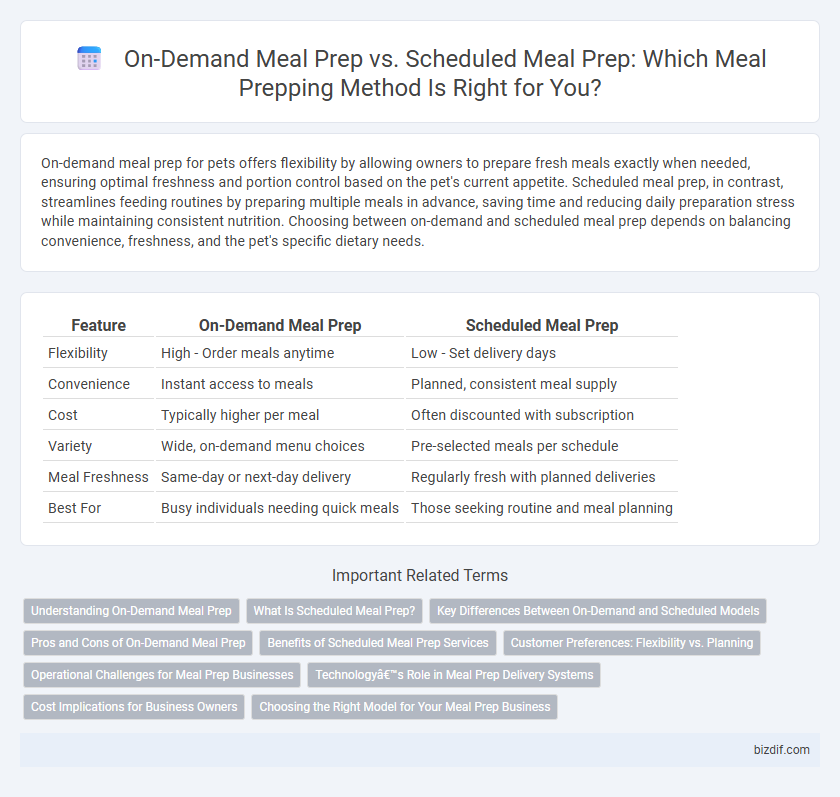On-demand meal prep for pets offers flexibility by allowing owners to prepare fresh meals exactly when needed, ensuring optimal freshness and portion control based on the pet's current appetite. Scheduled meal prep, in contrast, streamlines feeding routines by preparing multiple meals in advance, saving time and reducing daily preparation stress while maintaining consistent nutrition. Choosing between on-demand and scheduled meal prep depends on balancing convenience, freshness, and the pet's specific dietary needs.
Table of Comparison
| Feature | On-Demand Meal Prep | Scheduled Meal Prep |
|---|---|---|
| Flexibility | High - Order meals anytime | Low - Set delivery days |
| Convenience | Instant access to meals | Planned, consistent meal supply |
| Cost | Typically higher per meal | Often discounted with subscription |
| Variety | Wide, on-demand menu choices | Pre-selected meals per schedule |
| Meal Freshness | Same-day or next-day delivery | Regularly fresh with planned deliveries |
| Best For | Busy individuals needing quick meals | Those seeking routine and meal planning |
Understanding On-Demand Meal Prep
On-demand meal prep offers flexibility by allowing individuals to prepare meals as needed, catering to spontaneous schedules and changing dietary preferences. This method reduces food waste and maximizes freshness by avoiding pre-planned bulk cooking, making it ideal for those with unpredictable routines. Utilizing apps and delivery services enhances convenience, providing customized meal options without long-term commitments.
What Is Scheduled Meal Prep?
Scheduled meal prep involves planning and preparing meals ahead of specific times or days, ensuring consistent availability of ready-to-eat dishes. This method often includes batch cooking on designated days, which helps streamline weekly nutrition and reduces daily cooking time. By adhering to a routine, scheduled meal prep supports balanced diets and minimizes food waste.
Key Differences Between On-Demand and Scheduled Models
On-demand meal prep offers flexibility by allowing customers to order meals as needed, catering to spontaneous schedules and dietary changes. Scheduled meal prep involves pre-planned menus and delivery times, promoting consistency and routine for clients who prefer structured meal planning. Key differences include order frequency, customization options, and convenience level, with on-demand emphasizing immediacy and scheduled focusing on long-term meal management.
Pros and Cons of On-Demand Meal Prep
On-demand meal prep offers flexibility by allowing individuals to prepare meals exactly when needed, reducing food waste and accommodating last-minute schedule changes. This approach can increase convenience for those with unpredictable routines but may lead to less efficient time management compared to scheduled meal prep. However, it often results in higher costs and inconsistent portion control due to the spontaneous nature of meal preparation.
Benefits of Scheduled Meal Prep Services
Scheduled meal prep services provide consistent access to healthy, nutritious meals tailored to dietary preferences, reducing daily decision fatigue. These services enhance time management by delivering meals at regular intervals, allowing for better planning and maintaining a structured eating routine. Reliable portion control and variety in meal options support long-term health goals and improve overall dietary adherence.
Customer Preferences: Flexibility vs. Planning
On-demand meal prep offers unmatched flexibility, allowing customers to order meals whenever their schedules change, ideal for those with unpredictable routines. Scheduled meal prep appeals to individuals who prefer structured planning, receiving meals consistently on set days to streamline weekly nutrition management. Customer preferences often hinge on lifestyle demands, with flexibility prioritizing spontaneity and scheduled prep emphasizing reliability and time-saving organization.
Operational Challenges for Meal Prep Businesses
On-demand meal prep services face operational challenges such as unpredictable order volumes that complicate inventory management and kitchen scheduling. Scheduled meal prep businesses manage workflow more efficiently but struggle with forecasting demand variability and adhering to rigid delivery timelines. Both models require robust logistics and supply chain coordination to maintain food quality, minimize waste, and optimize labor costs.
Technology’s Role in Meal Prep Delivery Systems
On-demand meal prep leverages real-time app-based ordering and GPS tracking technologies to provide rapid, customizable meal delivery tailored to immediate consumer needs. Scheduled meal prep systems utilize automated subscription platforms and AI-driven meal planning algorithms to optimize ingredient sourcing, reduce waste, and ensure timely delivery aligned with weekly routines. Integration of IoT sensors and cloud data analytics enhances the efficiency, accuracy, and user experience across both meal prep delivery models.
Cost Implications for Business Owners
On-demand meal prep services often incur higher operational costs due to unpredictable demand and the need for flexible staffing, impacting profit margins for business owners. Scheduled meal prep allows for bulk purchasing and streamlined production, reducing ingredient costs and labor expenses, thereby enhancing overall cost efficiency. Optimizing meal prep scheduling can significantly influence financial sustainability and pricing strategies in the food service industry.
Choosing the Right Model for Your Meal Prep Business
Choosing between on-demand meal prep and scheduled meal prep models depends on customer preferences and operational efficiency. On-demand meal prep offers flexibility and caters to spontaneous orders, ideal for customers who value variety and customization. Scheduled meal prep enhances predictability and streamlines inventory management, benefiting businesses focused on consistent meal plans and bulk preparation.
On-Demand Meal Prep vs Scheduled Meal Prep Infographic

 bizdif.com
bizdif.com